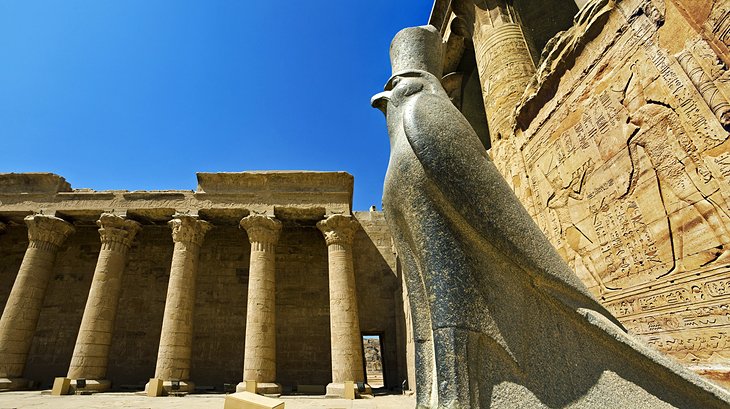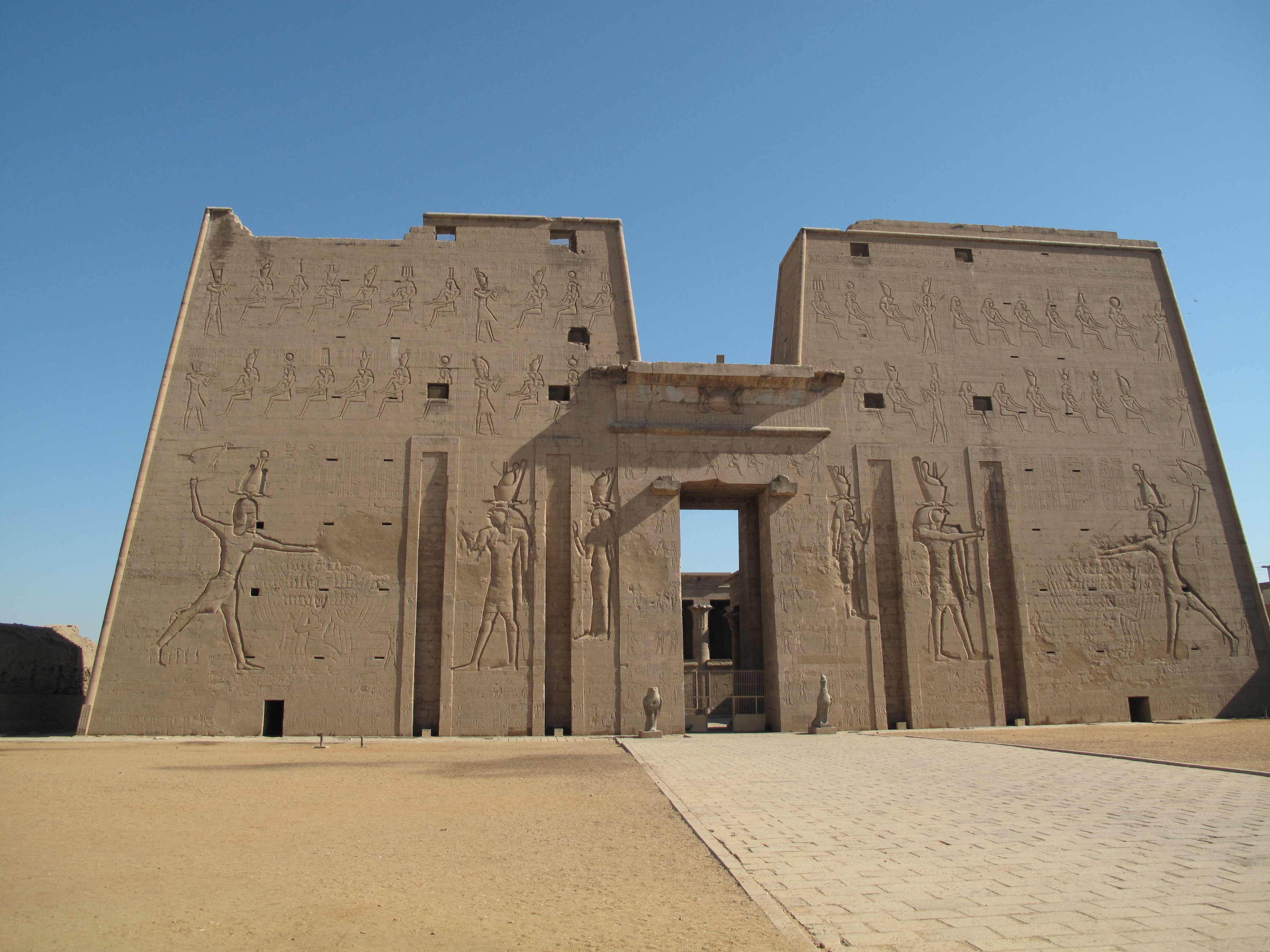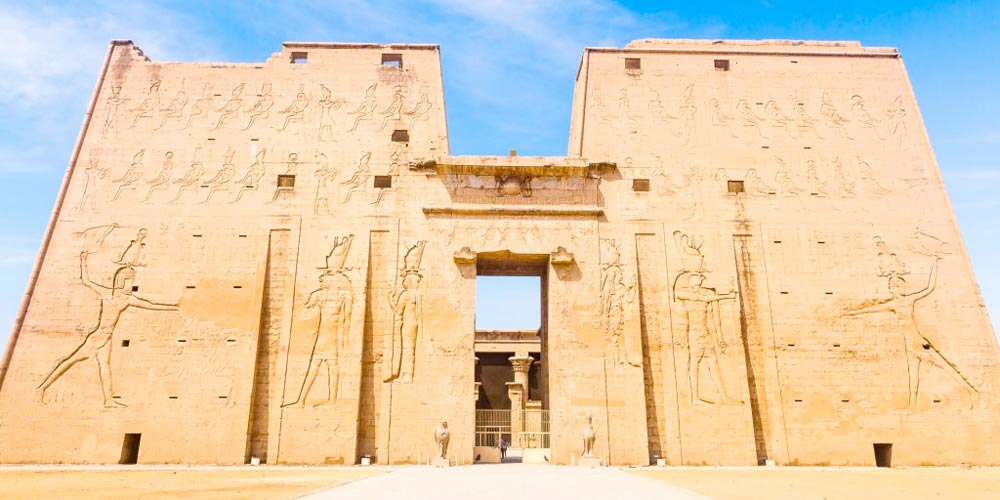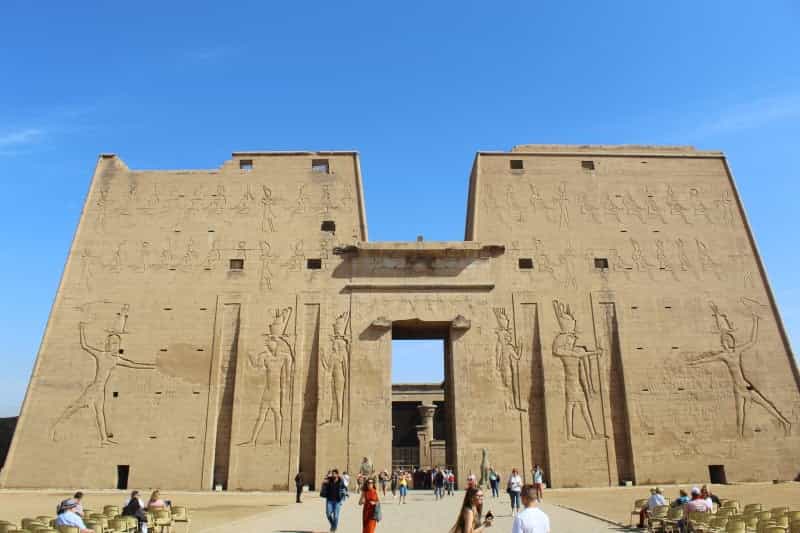Explore the Temple of Horus at Edfu: Egypt's Best-Preserved Ancient Temple
Are you a history enthusiast or someone fascinated by ancient Egyptian culture? If so, a visit to the Temple of Horus at Edfu is a must when travelling to Egypt. This remarkable temple is one of the most well-preserved ancient temples in Egypt and holds immense historical and cultural significance.
Overview of the Temple of Horus at Edfu
The Temple of Horus, also known as the Edfu Temple, is located in the city of Edfu in southern Egypt. This magnificent structure was built during the Ptolemaic period (between 237 and 57 BC) and is dedicated to the falcon-headed god Horus, one of the most important deities in the ancient Egyptian religion.
The temple has traditional Egyptian design features towering pylons, hypostyle halls, and beautifully adorned walls and ceilings. These architectural elements, along with the vibrant colours and intricate carvings, give visitors a glimpse into the grandeur of ancient Egyptian temple structures.
Significance and historical importance of the temple
The Temple of Horus at Edfu was crucial in the ancient Egyptian religious and cultural landscape. It was believed to be where the gods Horus and Hathor united in a symbolic marriage, emphasising the concept of harmony and balance in Egyptian mythology.
The temple also serves as an essential historical record, providing valuable insights into the ancient Egyptians' religious rituals, beliefs, and practices. The inscriptions on the temple walls depict various mythological stories, including the battle between Horus and Seth, one of the most famous tales in ancient Egyptian mythology.
Visitors to the temple can explore its various chambers and halls, including the hypostyle hall, which houses a stunning collection of columns adorned with intricate hieroglyphics. The main sanctuary, dedicated to the god Horus, is the most sacred part of the temple and is believed to have held the cult statue of the deity during ancient times.
With its remarkable state of preservation, the Temple of Horus offers visitors a unique opportunity to step back in time and experience the splendour of ancient Egypt firsthand. Whether you are a history buff or simply in awe of ancient architectural wonders, visiting the Temple of Horus at Edfu will surely leave you in awe of the ancient Egyptian civilization.
In the next blog section, we will explore some of the fascinating features and details of the Temple of Horus at Edfu, allowing you to get a closer look at this extraordinary ancient temple.

History and Architecture
One of the country's most remarkable ancient treasures lies in Edfu, Egypt, the Temple of Horus. Dedicated to the falcon-headed god Horus, this temple is considered the best-preserved ancient temple in Egypt. Its rich history and stunning architectural elements make it a must-visit destination for history enthusiasts and tourists alike.
Ancient Egyptian beliefs and worship of Horus
Horus, the son of Isis and Osiris, was one of the most important deities in ancient Egyptian mythology. He was believed to be the god of the sky, war, and protection. According to the ancient Egyptians, Horus was the protector of the reigning pharaoh, ensuring his victory and providing him divine guidance. The worship of Horus played a crucial role in ancient Egyptians' religious beliefs and rituals.
Architectural elements and design of the temple
The Temple of Horus was built during the Ptolemaic period, between 237 and 57 BCE. Its architectural design reflects the traditional Egyptian temple layout, consisting of an entrance, a courtyard, a hypostyle hall, and a sanctuary. The temple is surrounded by massive walls, creating a sense of grandeur and protection.
One of the standout features of the temple is its magnificent pylons. These monumental gateways are adorned with intricate carvings and hieroglyphics, depicting scenes from ancient Egyptian mythology and religious rituals. The pylons lead visitors into the vast courtyard, where they are greeted by the mesmerizing sight of Horus's colossal statues guarding the sanctuary's entrance.
Visitors can explore the hypostyle hall inside the temple, with its towering columns and detailed reliefs. The hall's ceiling features astronomical decorations, illustrating the ancient Egyptians' deep knowledge of celestial bodies. The craftsmanship and attention to detail in the reliefs and carvings showcase the ancient Egyptians' artistry and dedication to their religious beliefs.
To visualize the architectural elements and design of the Temple of Horus at Edfu, refer to the table below:
| Feature | Details |
|---|---|
| Location | Edfu, Egypt |
| Built | Between 237 and 57 BCE |
| Deity | Horus |
| Architectural Style | Traditional Egyptian temple layout |
| Pylons | Monumental gateways with intricate carvings |
| Courtyard | Decorated with colossal statues of Horus |
| Hypostyle Hall | Towering columns and detailed reliefs |
| Ceiling Decoration | Astronomical motifs representing celestial bodies |
Exploring the Temple of Horus at Edfu offers a fascinating insight into ancient Egyptian culture and religious practices. Its well-preserved state allows visitors to experience the grandeur and beauty of an ancient temple firsthand. With its rich history, stunning architecture, and spiritual significance, the Temple of Horus is truly a marvel to behold.

Temple Complex
The Temple of Horus at Edfu is one of Egypt's most remarkable and well-preserved ancient temples. Located on the west bank of the Nile River in the city of Edfu, this temple is dedicated to the falcon-headed god Horus, one of the most important deities in ancient Egyptian mythology. Built during the Ptolemaic period between 237 and 57 BCE, the temple complex is a testament to the time's incredible architectural and artistic achievements.
Layout and structure of the temple complex
The Temple of Horus at Edfu is considered one of Egypt's best-preserved ancient temples. Its impressive size and grandeur make it a must-visit for anyone interested in ancient Egyptian history and culture. The temple complex covers an area of approximately 13,000 square meters and consists of several structures, including the main temple, outer courtyards, and various smaller buildings.
The main temple is surrounded by massive mudbrick enclosure walls meant to protect the sacred space from intruders. The entrance to the temple is marked by an imposing pylon, or gateway, adorned with intricate carvings and hieroglyphs. Visitors can explore a series of halls, galleries, and chambers, each lavishly decorated with detailed reliefs depicting scenes from ancient Egyptian mythology and religious rituals.
Important areas within the complex
Within the temple complex, several areas of particular significance should not be missed. These include:
-
Hypostyle Hall: This hall is one of the most impressive areas of the temple. It features a forest of massive columns, each intricately carved with hieroglyphs and scenes depicting the pharaoh's military victories and religious ceremonies.
-
Sanctuary: At the heart of the temple complex is the sanctuary, the most sacred area of the temple. It housed a statue of Horus and was accessible only to priests.
-
Offering Halls: Located near the sanctuary, these halls were used for offerings to the gods. The walls of these halls are adorned with vivid scenes depicting the preparation and presentation of offerings.
-
Sacred Lake: In ancient Egyptian religious rituals, purification was important. The temple complex at Edfu contains a large sacred lake, where priests would perform cleansing rituals before entering the temple.
Exploring the Temple of Horus at Edfu is like returning to ancient Egypt. The intricate carvings, colourful reliefs, and well-preserved architecture provide a fascinating glimpse into this ancient civilisation's religious beliefs and practices. So, if you're planning a trip to Egypt, don't miss the opportunity to visit this incredible temple complex that has stood the test of time.

Decorations and Reliefs
When visiting the historic city of Edfu in Egypt, one cannot miss the magnificent Temple of Horus. This temple, dedicated to the falcon-headed god Horus, is not only one of the best-preserved ancient temples in Egypt but also a marvel to behold. The temple is known for its elaborate decorations and intricate reliefs that provide valuable insights into ancient Egyptian mythology and culture.
Intricate carvings and reliefs depicting ancient Egyptian mythology
The Temple of Horus is adorned with impressive carvings and reliefs that cover its walls, columns, and façade. These intricate artworks depict scenes and stories from ancient Egyptian mythology, offering a visual feast for visitors. The reliefs depict mythical creatures, divine beings, and important events from Egyptian history. One of the highlights is the Battle of Horus and Seth, a timeless symbol of good triumphing over evil. The level of detail in the carvings is awe-inspiring, showcasing the craftsmanship and skill of ancient Egyptian artisans.
Symbolism and meanings behind the artwork
Each carving and relief in the Temple of Horus carries symbolism and deeper meanings from ancient Egyptian mythology. These intricate artworks were for decorative purposes and as teaching tools and reminders of the gods' power and protection. Many reliefs depict rituals and offerings to the gods, symbolizing the ancient Egyptians' devotion and belief in the divine. Visitors can decipher the symbolism behind the scenes depicted, bringing them closer to understanding the ancient Egyptian worldview.
Here's a glimpse of some of the fascinating carvings and reliefs found in the Temple of Horus:
- The famous Pylon Gateway, adorned with reliefs of the Pharaoh making offerings to Horus, symbolizing the divine right of kingship.
- The Hypostyle Hall features massive columns intricately carved with floral motifs and depictions of deities and pharaohs.
- The Sanctuary, the innermost part of the temple, where the sacred statue of Horus was kept. The walls here are covered with reliefs depicting the rituals performed to honour the god.
- The birth scenes of Horus symbolise the continuous cycle of life and renewal in Egyptian mythology.
Visiting the Temple of Horus at Edfu is like stepping back in time, allowing you to immerse yourself in the ancient Egyptian world. The detailed carvings and reliefs offer a glimpse into the lives, beliefs, and values of the ancient Egyptians. It is a testament to their rich culture and artistic prowess and a must-visit destination for history enthusiasts and travellers alike.

Temple of Horus Festival
The Temple of Horus at Edfu is Egypt's best-preserved ancient temple and the setting for a vibrant and exciting annual festival. The festival, held in honour of the falcon-headed god Horus, attracts locals and tourists who come to experience this ancient site's rich traditions and celebrations. Let's look at what makes the Temple of Horus Festival so special.
Overview of the annual festival held at the temple
The Temple of Horus Festival, also known as the "Festival of Drunkenness," takes place for several days and offers a unique opportunity to witness ancient Egyptian rituals and traditions. The festival dates back thousands of years and plays an important role in the region's cultural heritage. It is a celebration of the marriage between the goddess Hathor and the god Horus, symbolizing the renewal of life and fertility.
The temple comes alive during the festival with colourful decorations, lively music, and performances. Visitors can witness processions, dances, and reenactments of ancient ceremonies. The air is filled with the aroma of incense, and joyful chants reverberate throughout the temple grounds.
Traditional rituals and celebrations during the festival
The Temple of Horus Festival features a range of traditional rituals and celebrations that offer a glimpse into the ancient Egyptian way of life. One of the highlights is the "Feeding of the Gods" ceremony, where food and drink offerings are presented to the deities. This ritual is believed to ensure their favour and seek blessings for the coming year.
Another fascinating festival aspect is the "Mysteries of Osiris" play. This theatrical performance reenacts the ancient Egyptian myth of the murder and resurrection of Osiris, the god of the afterlife. The play accompanies music, dance, and elaborate costumes, creating a mesmerizing spectacle for all attendees.
Here's a table to help you understand the main features of the Temple of Horus Festival:
| Feature | Temple of Horus Festival |
|---|---|
| Purpose | Honor the god Horus and celebrate ancient Egyptian traditions |
| Duration | Several days |
| Rituals and Celebrations | Processions, dances, reenactments, Feeding of the Gods, Mysteries of Osiris play |
| Cultural Significance | Cultural heritage, renewal of life and fertility |
Visiting the Temple of Horus during the festival is an incredible experience that allows you to immerse yourself in ancient Egypt's rich history and traditions. From witnessing ancient rituals to marvelling at the architectural beauty of the temple itself, it is an adventure that should not be missed.
Whether you are a history enthusiast or simply looking for a unique cultural experience, the Temple of Horus Festival offers an unforgettable journey through time. So plan your visit, immerse yourself in the vibrant atmosphere, and create memories that will last.

Visitor Experience
When travelling to Egypt, one cannot miss the opportunity to explore the awe-inspiring Temple of Horus at Edfu. Situated on the west bank of the Nile River, this is Egypt's best-preserved ancient temple and a testament to the architectural prowess of the ancient Egyptians. Dating back to the Ptolemaic period, the temple is dedicated to the falcon-headed god Horus and provides visitors with a unique glimpse into the country's rich history and culture.
Visiting the Temple of Horus at Edfu today
Visitors can easily reach the Temple of Horus at Edfu by taking a felucca boat ride across the Nile or hiring a taxi or tour guide. Upon arrival, visitors are greeted by the temple's grand entrance, adorned with marvellous carvings and hieroglyphics. You'll be transported back to the ancient world as you step inside, marvelling at the intricate details and well-preserved artwork.
The temple consists of various chambers and halls designed for specific rituals and ceremonies. As you explore, you'll come across the Great Hypostyle Hall with towering columns and beautifully decorated walls depicting scenes from ancient Egyptian mythology. The inner sanctum houses the sacred shrine of Horus, a place of worship and reverence for ancient Egyptians.
One of the highlights of the visit is the opportunity to climb to the temple's rooftop. From there, you can enjoy panoramic views of the surrounding landscape and the Nile River. It's a perfect spot to capture breathtaking photos and appreciate the sheer magnificence of the temple's architecture.
Tips for exploring and appreciating the temple
To make the most of your visit to the Temple of Horus at Edfu, here are some tips:
-
Plan your visit: Check the opening hours and any special events or ceremonies at the temple to optimize your experience.
-
Engage a knowledgeable guide: Hiring a local guide can provide in-depth knowledge and insights into the temple's history and significance.
-
Bring appropriate clothing and accessories: Egypt's climate can be hot, so lightweight and breathable clothing is recommended. Don't forget to carry a hat, sunglasses, and sunscreen.
-
Respect the rules and regulations: As with any historical site, it's important to respect the rules and guidelines set by the authorities. This includes not touching the ancient carvings and refraining from disruptive behaviour.
-
Take your time: The Temple of Horus at Edfu is a treasure trove of ancient delights. Take your time to soak in the atmosphere, appreciate the details, and imagine the rituals that once took place within these ancient walls.
Visiting the Temple of Horus at Edfu is a journey back through time, allowing you to connect with the spirit of ancient Egypt. Its remarkable preservation and captivating architecture make it a must-visit destination for history enthusiasts and travellers alike.
